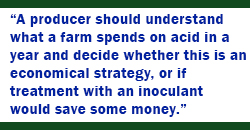
To buchneri or not to buchneri?
 By Dr. Michelle Der Bedrosian, Vita Plus forage products and dairy technical specialist
By Dr. Michelle Der Bedrosian, Vita Plus forage products and dairy technical specialistThe decision of which inoculant to use is an important one. Feed inventories are low across the country due to higher feed intakes during the winter, extensive alfalfa winterkill, an extremely wet spring and a significantly late planting season. Many farms are out of corn silage and are going to need to feed green-chopped corn silage immediately. This is not the year to skimp on inoculants.
The three main types of inoculants are upfront fermenters, spoilage inhibitors and combination inoculants.
Upfront fermenters
Upfront fermenters help minimize dry matter (DM) losses by dropping pH quickly via a rapid production of lactic acid. In other words, less of the crop is turned into a gas by fermentation, preserving more high-quality feed for the cows. The other added benefit of this rapid pH drop is the “bad” bacteria, such as Clostridia and enterobacteria, don’t have an opportunity to grow. I recommend all feeds be treated with an upfront fermenter because the goal of making all feeds is to maximize the yield of high-quality feed per acre. Some example strains of upfront fermenters are Lactobacillus plantarum and Pediococcus pentosaceus.
Spoilage inhibitors
You can tell if your feed is spoiling simply by feeling the TMR with your hand. If the feed is hot, it is spoiling. This means the yeast is consuming lactic acid, raising the pH of the silage, and destroying quality nutrients, which creates heat and provides an ideal environment for the growth of molds. An inoculant that produces an antifungal compound can slow this process.
 Propionic acid and acetic acid are the two main antifungal compounds. Many people choose to treat silages after ensiling with acids. This may or may not be a wise financial decision. A producer should understand what a farm spends on acid in a year and decide whether this is an economical strategy, or if treatment with an inoculant would save some money. I recently calculated this on a farm and found that switching from an acid to a spoilage-inhibiting inoculant would save more than $3,000 and 120 hours of labor.
Propionic acid and acetic acid are the two main antifungal compounds. Many people choose to treat silages after ensiling with acids. This may or may not be a wise financial decision. A producer should understand what a farm spends on acid in a year and decide whether this is an economical strategy, or if treatment with an inoculant would save some money. I recently calculated this on a farm and found that switching from an acid to a spoilage-inhibiting inoculant would save more than $3,000 and 120 hours of labor.
Mainly two strains of bacteria that produce antifungal acids are used in inoculants: Propionibacteria produces propionic acid, but the bacteria are extremely sensitive to a lower pH, such as the environment in a silo. Lactobacillus buchneri produces acetic acid and is very tolerant of a low pH.
Many people ask me, “Should I use L. buchneri on my crop?” My answer is it depends on whether you have the potential for a spoilage problem. If the answer is no, then an upfront fermenter should do the job.
However, if you had a spoilage problem this year, odds are you will have one next year. Many factors can cause spoilage problems, including, but not limited to, not achieving ideal DM values, a slower-than-ideal feedout rate, poor packing density, slow silo filling, repeated rain events during harvest, a high silage pH, bird/critter pressure, and delayed silo sealing.
At the end of the day, if it is a spoilage problem, the return on investment favors L. buchneri-based inoculants. Your Vita Plus consultant has tools and knowledge to help your farm assess spoilage and solve forage management issues.
| Category: |
Forage Foundations Forage inoculants Silages |

